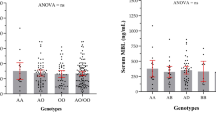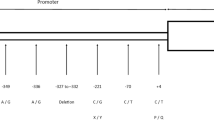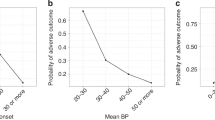Abstract
Objective:
The aim of this study was to determine the serum mannose-binding lectin (MBL) levels and the frequency of MBL gene polymorphisms in infants with neonatal sepsis.
Study Design:
Between January 2008 and January 2010, a total of 93 infants were included in this study and 53 of them had neonatal sepsis diagnosis as study group and 40 infants who had no sepsis according to clinical and laboratory findings as control group.
Result:
Serum MBL levels were found to be low in 17 of 93 infants. Eleven of them were in the sepsis group and six of them were in the control group. Serum MBL levels were significantly lower in infants with sepsis compared with the control group. Frequencies of genotype AB and BB were also significantly higher in the study group compared with the control group. Most importantly, presence of B allele of MBL exon 1 gene was found to be associated with an increased risk for neonatal sepsis. Additionally, in the study group, the mean serum MBL levels were found to be significantly lower in the premature infants compared with the term infants. Pneumonia, bronchopulmonary dysplasia (BPD) and intraventricular hemorrhage (IVH) were significantly higher in infants with MBL deficiency compared with infants with normal MBL levels.
Conclusion:
Low MBL levels and presence of B allele of MBL exon 1 gene were found to be important risk factors for development of both neonatal sepsis and pneumonia, especially in premature infants. Low MBL levels and MBL gene polymorphisms might also be associated with inflammation-related neonatal morbidities such as BPD and IVH.
This is a preview of subscription content, access via your institution
Access options
Subscribe to this journal
Receive 12 print issues and online access
$259.00 per year
only $21.58 per issue
Buy this article
- Purchase on SpringerLink
- Instant access to full article PDF
Prices may be subject to local taxes which are calculated during checkout

Similar content being viewed by others
References
de Benedetti F, Auriti C, D'Urbano LE, Ronchetti MP, Ravà L, Tozzi A et al. Low serum levels of mannose binding lectin are a risk factor for neonatal sepsis. Pediatr Res 2007; 61: 325–328.
Neth O, Jack DL, Dodds AW, Holzel H . Mannose-binding lectin binds to a range of clinically relevant microorganisms and promotes complement deposition. Infect Immun 2000; 68: 688–693.
Madsen HO, Garred P, Thiel S, Kurtzhals JA, Lamm LU, Ryder LP et al. Interplay between promoter and structural gene variants control basal serum level of mannan-binding protein. J Immunol 1995; 155: 3013–3020.
Selander B, Martensson U, Weintraub A, Holmström E, Matsushita M, Thiel S et al. Mannan-binding lectin activates C3 and the alternative complement pathway without involvement of C2. J Clin Invest 2006; 116: 1425–1434.
Kilpatrick DC . Mannan-binding lectin: clinical significance and applications. Biochim Biophys Acta 2002; 1572: 401–413.
Neth O, Hann I, Turner MW, Klein NJ . Deficiency of mannose-binding lectin and burden of infection in children with malignancy: a prospective study. Lancet 2001; 358: 614.
Roy S, Knox K, Segal S, Griffiths D, Moore CE, Welsh KI et al. MBL genotype and risk of invasive pneumococcal disease: a case-control study. Lancet 2002; 359: 1569–1573.
Sandberg K, Fasth A, Berger A . Preterm infants with low immunoglobulin G levels have increased risk of neonatal sepsis but do not benefit from prophylactic immunoglobulin G. J Pediatr 2000; 137: 623–628.
Geelen SP, Fleer A, Bezemer AC . Deficiencies in opsonic defense to pneumococci in the human newborn despite adequate levels of complement and specific IgG antibodies. Pediatr Res 1990; 27: 514–518.
Dzwonek AB, Neth OW, Thiébaut R, Gulczynska E, Chilton M, Hellwig T et al. The role of mannose-binding lectin in susceptibility to infection in preterm neonates. Pediatr Res 2008; 63: 680–685.
Israëls J, Frakking FN, Kremer LC, Offringa M, Kuijpers TW, van de Wetering MD . Mannose-binding lectin and infection risk in newborns: a systematic review. Arch Dis Child Fetal Neonatal Ed 2010; 95: F452–F461.
Koroglu OA, Onay H, Erdemir G, Yalaz M, Cakmak B, Akius M et al. Mannose-binding lectin gene polymorphism and early neonatal outcome in preterm infants. Neonatology 2010; 98: 305–312.
Frakking FN, Brouwer N, van Eijkelenburg NKA, Merkus MP, Kuijpers TW, Offringa M et al. Low mannose-binding lectin (MBL) levels in neonates with pneumonia and sepsis. Clin Exp Immunol 2007; 150: 255–262.
Ahrens P, Kattner E, Kohler B, Hartel C, Seidenberg J, Segerer H et al. Mutations of genes involved in the innate immune system as predictors of sepsis in very low birth weight infants. Pediatr Res 2004; 55: 652–656.
van der Zwet WC, Catsburg A, van Elburg RM, Savelkoul PH, Vandenbroucke-Grauls CM . Mannose-binding lectin (MBL) genotype in relation to risk of nosocomial infection in pre-term neonates in the neonatal intensive care unit. Clin Microbiol Infect 2008; 14: 130–135.
Hilgendorff A, Schmidt R, Bohnert A, Merz C, Bein G, Gortner L . Host defence lectins in preterm neonates. Acta Paediatr 2005; 94: 794–799.
Sankar JM, Agarwal R, Deorari AK, Paul VK . Sepsis in the newborn. Indian J Pediatr 2008; 75: 261–266.
Papile LA, Burstein J, Burstein R, Koffler H . Incidence and evolution of subependymal and intraventricular hemorrhage: a study of infants with birth weights less than 1,500gm. J Pediatr 1978; 92: 529–534.
Jobe AH, Bancalari E . Bronchopulmonary dysplasia. Am J Respir Crit Care Med 2001; 163: 1723–1729.
Walsh MC, Kliegman RM . Necrotizing enterocolitis: treatment based on staging criteria. Pediatr Clin North Am 1986; 33: 179–201.
International Committee for the Classification of Retinopathy of Prematurity. The International Classification of Retinopathy of Prematurity revisited. Arch Ophthalmol 2005; 123: 991–999.
Manroe BL, Weinberg AG, Rosenfeld CR, Browne R . The neonatal blood count in health and disease. I. Reference values for neutrophilic cells. J Pediatr 1979; 95: 89–98.
Rodwell RL, Leslie AL, Tudehope DI . Early diagnosis of neonatal sepsis using a hematological scoring system. J Pediatr 1988; 112: 761–767.
Vardar F, Pehlivan S, Onay H, Atlihan F, Güliz N, Ozkinay C et al. Association between mannose binding lectin polymorphisms and predisposition to bacterial meningitis. Turk J Pediatr 2007; 49: 270–273.
Epstein J, Eichbaum Q, Sheriff S, Ezekowitz RAB . The collectins in innate immunity. Curr Opin Immunol 1996; 8: 29–35.
Koch A, Melbye M, Sørensen P, Homøe P, Madsen HO, Mølbak K et al. Acute respiratory tract infections and mannose-binding lectin insufficiency during early childhood. JAMA 2001; 285: 1316–1321.
Eisen DP, Dean MM, Boermeester MA, Fidler KJ, Gordon AC, Kronborg G et al. Low serum mannose-binding lectin level increases the risk of death due to pneumococcal infection. Clin Infect Dis 2008; 47: 510–516.
Dumestre-Pérard C, Doerr E, Colomb MG, Loos M . Involvement of complement pathways in patients with bacterial septicemia. Mol Immunol 2007; 44: 1631–1638.
Kielgast S, Thiel S, Henriksen TB, Bjerke S, Olsen J, Jensenius JC . Umblical cord mannan-binding lectin and infections in early childhood. Scand J Immunol 2003; 57: 167–172.
Frakking FN, Brouwer N, Zweers D, Merkus MP, Kuijpers TW, Offringa M et al. High prevalence of mannose-binding lectin (MBL) deficiency in premature neonates. Clin Exp Immunol 2006; 145: 5–12.
Ozdemir O, Dinleyici EC, Tekin N, Colak O, Aksit MA . Low-mannose-binding lectin levels in susceptibility to neonatal sepsis in preterm neonates with fetal inflammatory response syndrome. J Matern Fetal Neonatal Med 2010; 23: 1009–1013.
Lau YL, Chan SY, Turner MW . Mannose-binding protein in preterm infants: developmental profile and clinical significance. Clin Exp Immunol 1995; 102: 649–654.
Vallinoto AC, da Silva RF, Hermes RB, Amaral IS, Miranda EC, Barbosa MS et al. Mannose-binding lectin gene polymorphisms are not associated with susceptibility to hepatitis C virus infection in the Brazilian Amazon region. Hum Immunol 2009; 70: 754–757.
Herpers BL, Yzerman EP, de Jong BA, Bruin JP, Lettinga KD, Kuipers S et al. Deficient mannose binding lectin-mediated complement activation despite mannose binding lectin-sufficient genotypes in an outbreak of Legionella pneumophila pneumonia. Hum Immunol 2009; 70: 125–129.
Eisen DP, Minchinton RM . Impact of mannose binding lectin on susceptibility to infectious diseases. Clin Infect Dis 2003; 37: 1496–1505.
Summerfield JA, Sumiya M, Levin M, Turner MW . Association of mutations in mannose binding protein gene with childhood infection in consecutive hospital series. BMJ 1997; 314: 1229–1232.
Schlapbach LJ, Latzin P, Regamey N, Kuehni CE, Zwahlen M, Casaulta C et al. Mannose-binding lectin cord blood levels and respiratory symptoms during infancy: a prospective birth cohort study. Pediatr Allergy Immunol 2009; 20: 219–226.
Hibbert ML, Sumiya M, Summerfield JA, Booy R, Levin M . Association of variants of the gene for mannose-binding lectin with susceptibility to meningococcal disease. Lancet 1999; 353: 1049–1053.
Garred P, Michaelsen TE, Bjune G, Thiel S, Svejgaard A . A low serum concentration of mannan-binding protein is not associated with serogroup B or C meningococcal disease. Scand J Immunol 1993; 37: 468–470.
Hilgendorff A, Heidinger K, Pfeiffer A, Bohnert A, König IR, Ziegler A et al. Association of polymorphisms in the mannose-binding lectin gene and pulmonary morbidity in preterm infants. Genes Immun 2007; 8: 671–677.
Capoluongo E, Vento G, Rocchetti S, Giardina E, Concolino P, Sinibaldi C et al. Mannose-binding lectin polymorphisms and pulmonary outcome in premature neonates: a pilot study. Intensive Care Med 2007; 33: 1787–1794.
Acknowledgements
This study was supported by Uludag University Scientific Research Project with a project number T-2006/52.
Author information
Authors and Affiliations
Corresponding author
Ethics declarations
Competing interests
The authors declare no conflict of interest.
Rights and permissions
About this article
Cite this article
Özkan, H., Köksal, N., Çetinkaya, M. et al. Serum mannose-binding lectin (MBL) gene polymorphism and low MBL levels are associated with neonatal sepsis and pneumonia. J Perinatol 32, 210–217 (2012). https://doi.org/10.1038/jp.2011.79
Received:
Revised:
Accepted:
Published:
Issue date:
DOI: https://doi.org/10.1038/jp.2011.79
Keywords
This article is cited by
-
Association between innate immunity gene polymorphisms and neonatal sepsis development: a systematic review and meta-analysis
World Journal of Pediatrics (2022)
-
Levels of mannose-binding lectin (MBL) associates with sepsis-related in-hospital mortality in women
Journal of Inflammation (2020)
-
Inter-individual variation in health and disease associated with pulmonary infectious agents
Mammalian Genome (2018)
-
An ADAM10 promoter polymorphism is a functional variant in severe sepsis patients and confers susceptibility to the development of sepsis
Critical Care (2015)
-
Relationship of Serum Mannose-Binding Lectin Levels with the Development of Sepsis: a Meta-analysis
Inflammation (2015)



